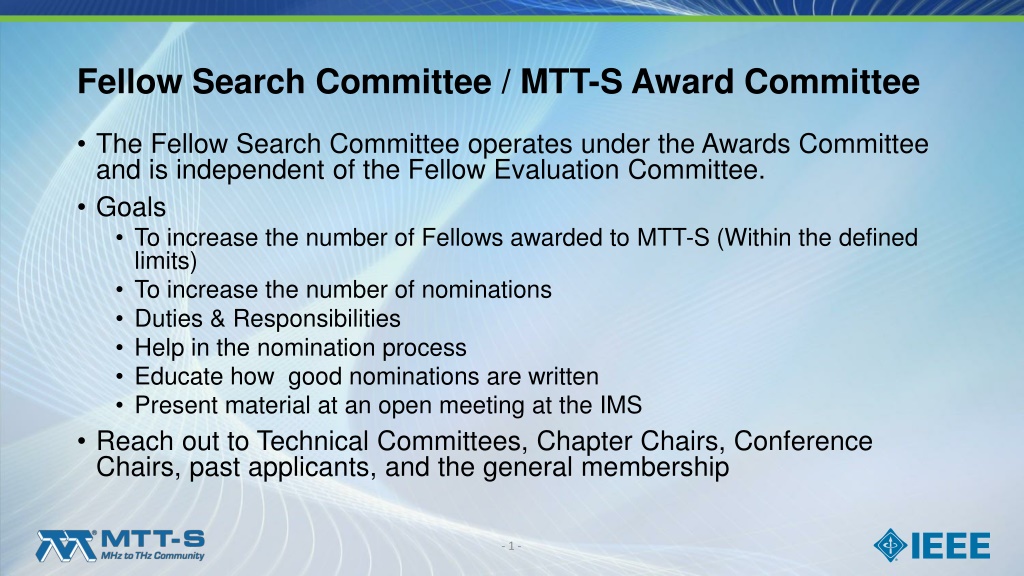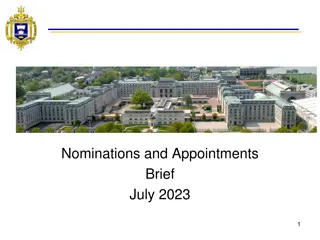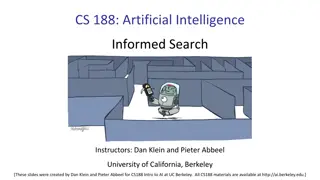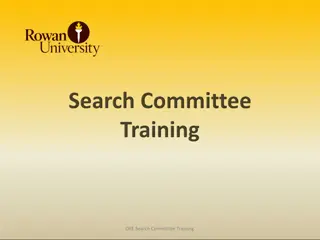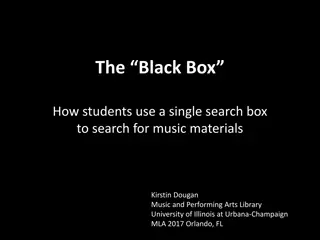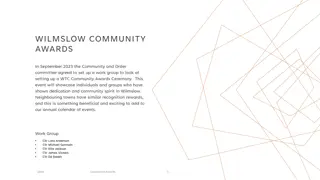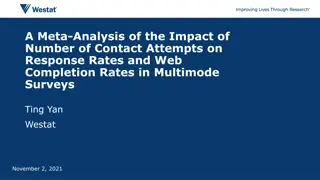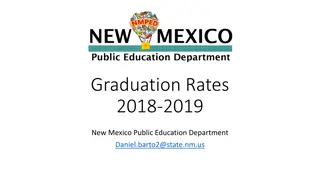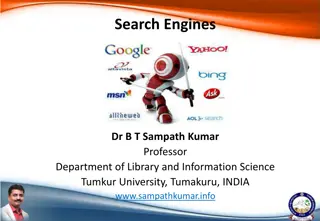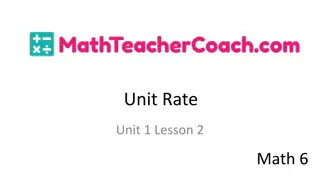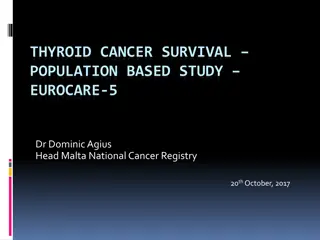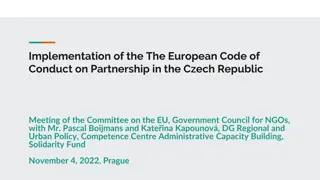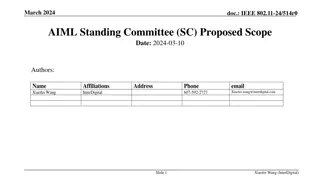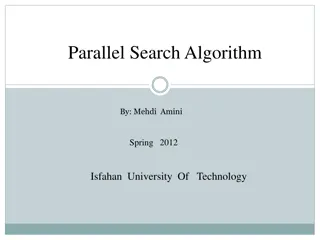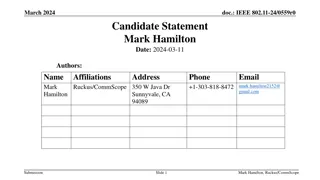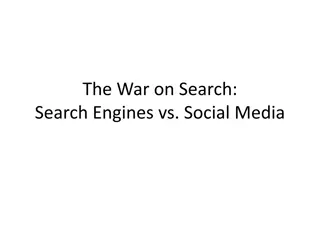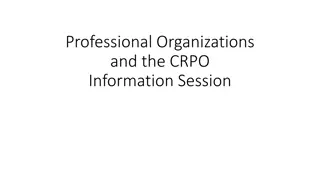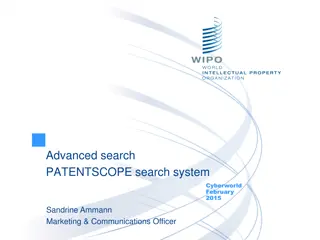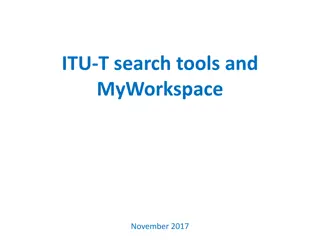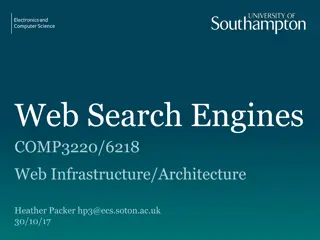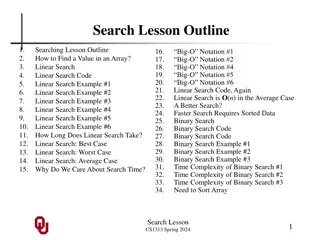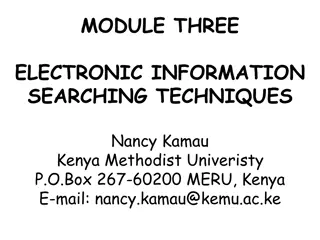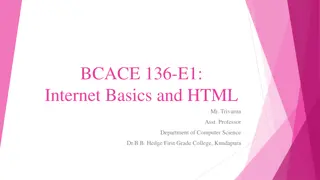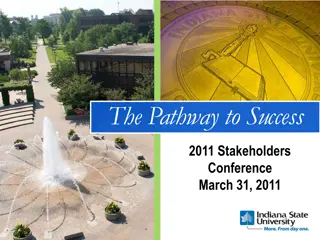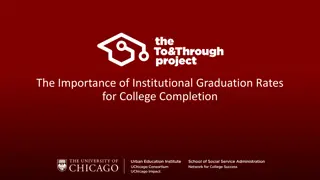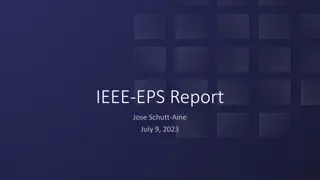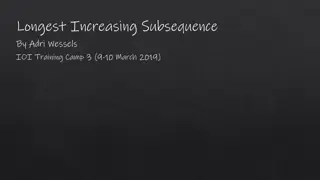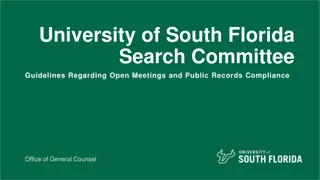IEEE Fellow Search Committee - Increasing Success Rates and Nominations
The IEEE Fellow Search Committee within MTT-S Award Committee aims to increase the number of IEEE Fellows awarded to MTT-S by enhancing nomination success rates. The committee provides support to nominators, educates on nomination best practices, and reaches out to relevant stakeholders. With a focus on expanding nominees and improving success rates, the committee presents valuable tips for nominators and outlines requirements for Fellow nominations, emphasizing contributions to engineering, science, and technology.
Download Presentation

Please find below an Image/Link to download the presentation.
The content on the website is provided AS IS for your information and personal use only. It may not be sold, licensed, or shared on other websites without obtaining consent from the author. Download presentation by click this link. If you encounter any issues during the download, it is possible that the publisher has removed the file from their server.
E N D
Presentation Transcript
Fellow Search Committee / MTT-S Award Committee The Fellow Search Committee operates under the Awards Committee and is independent of the Fellow Evaluation Committee. Goals To increase the number of Fellows awarded to MTT-S (Within the defined limits) To increase the number of nominations Duties & Responsibilities Help in the nomination process Educate how good nominations are written Present material at an open meeting at the IMS Reach out to Technical Committees, Chapter Chairs, Conference Chairs, past applicants, and the general membership - 1 -
Fellow Search Committee / MTT-S Award Committee Composition in 2023 Victor Fouad Hanna, Chair, Victor.fouad@ieee.org Charlie Jackson, past chair C.Jackson@ieee.org Edward Rezek, Member E.rezek@ieee.org Kamran Ghorbani, Member, kamran.ghorbani@rmit.edu.au Raafat Mansour, Member rrmansour@uwaterloo.ca - 2 -
Fellow Search Committee / MTT-S Award Committee IEEE Fellows Nominated by MTT-S The average Nomination Success rate during last 14 years is 34,3 % The average Nomination Success rate during last 3 years is 41 % The average annual nomination success rate for the whole IEEE is around 30 %. From 2023 to 2024: The number of nominees is increased from 20 to 28 while the success rate is increased from 0.35 to 0.43 (highest success rate for MTT-S since 2011) 2011 2012 2013 2014 2015 2016 2017 2020 2021 2022 2023 2024 2018 2019 Fellow Class 40 32 31 20 28 35 26 24 29 34 26 29 26 17 Nominees 9 4 13 7 12 14 12 10 10 10 10 8 11 6 Success 0.23 0.13 0.42 0,35 0,43 0.40 0.46 0.42 0.34 0.29 0.38 0.28 0.42 0.35 Success Rate
Tips on how to submit a successful IEEE Fellow Nomination presented by the MTT Fellow Search Committee Microwave Theory and Technology Society (MTT-S) is offering its members support with preparing an IEEE Fellow Nomination. These tips are targeted to nominators for prospective nominees. First-time nominators are often struggling to prepare a successful IEEE Fellow Nomination for a well-qualified nominee. The objective of these tips is to elaborate on the process and clarify the expectations in order to increase the chances for a successful Fellow elevation. Next to reviewing the Fellow submission process, the duties of the nominator and references will be covered. Finally, some tips on how to write effective nominations will be presented. - 4 -
Requirements for Fellow nomination (Who can become a Fellow) At the time the nomination is submitted, a nominee must: have accomplishments that have contributed importantly to the advancement or application of engineering, science and technology, bringing the realization of significant value to society; hold IEEE Senior member or IEEE Life Senior member grade; have been a member in good standing and has completed a minimum of five full years (consecutive or not) of IEEE membership in any grade preceding 1 January of the year of elevation. Note: IEEE Society affiliation membership does not apply. Non-eligibility: The nominee cannot be a member of the IEEE Fellow Committee and its Subcommittees, an IEEE Society/Technical Council Fellow Evaluating Committee Chair, a member of IEEE Society/Technical Council Fellow Evaluating Committees reviewing the nomination, members of the IEEE Board of Directors, or members who are prohibited from publishing in IEEE publications or committed Plagiarism violations or other forms of major publication misconduct outside of IEEE. . - 5 -
Who can be a Nominator Any person, including non-IEEE members, is eligible to serve as a nominator. The following are exceptions: members of the IEEE Board of Directors, members of the IEEE Fellow Committee and its Subcommittees, IEEE Society/Technical Council Fellow Evaluating Committee Chairs, Vice-Chairs, and members of IEEE Society/Technical Council Fellow Evaluating Committee reviewing the nomination, or IEEE staff. Self-nomination is not permitted. But the Nominator can work with the Nominee - 6 -
Nominators responsibility . The nominator is responsible for preparing the IEEE Fellow Grade Nomination Form and submitting it to the web no later than the deadline, February 07, 2024 for 2025 Fellows promotion, The nominator is responsible for identifying an IEEE Society/Technical Council whose evaluating committee will assess the nominee s technical qualifications and contributions. The nominator is responsible for soliciting at least three, but no more than five, references capable of assessing the nominee s contributions. (NOTE: A reference must be an IEEE Fellow in good standing. The following individuals are ineligible to serve as IEEE Fellow references: members of the IEEE Board of Directors, members of the Fellow Committee and its Subcommittees, members of the IEEE Society/Technical Council Fellow Evaluating Committee reviewing the nomination or IEEE Staff. In addition, a nominator may not serve as a reference for a nomination he/she is submitting. Exception: References will be accepted if a reference is an IEEE Senior or Life Senior member from Region 9, in good standing and the nominee they are serving as a reference resides in Region 9). Identify a maximum of 3 Endorsements (optional). - 7 -
Prepare the Nomination Strong Write-up Reference Endorsement Web Based Submission - 8 -
The Fellow Process evaluation (1) The first level evaluation consists of two steps. The first step of the first level is completed by the Society/Technical Council (S/TC) that is identified on the nomination form. The S/TC evaluation is a review of the impact of the nominee s contributions by at least two in-field (expert who is familiar or very familiar with the technical area of the nomination). evaluators. The S/TC Fellow Evaluating Committee (S/TC FEC) will meet and rank all its nominations and will forward the evaluators comments, scores, and its ranking report to the Cohort Fellow Evaluating Committee (CFEC). - 9 -
The Fellow Process evaluation (2) The second step of the first level evaluation is completed by a CFEC The goal of the CFEC is to provide the IEEE Fellow Committee with a critical evaluation and assessment of the Nominees. The CFEC produces a final normalized ranking report and forwards to the IEEE FC (Fellow Committee) for use in the IEEE FC evaluation: its ranking and report, with the evaluations and raw scores for the nominations and the S/TC-FEC rankings and reports. The second level evaluation is completed by the IEEE FC The IEEE FC performs a detailed review of all the nominations in view of the all the documents forwarded by the CFEC and a global ranking of all the nominations is generated and a final review of the list is assessed one more time by the entire IEEE FC. The slate of nominees is submitted by the IEEE Fellow Committee to the IEEE Board of Directors during the 3rd quarter, and the Board acts upon those recommendations at its year-end meeting. According to IEEE Bylaw I-305.5, the total number of Fellow recommendations in any one-year must not exceed one-tenth of one percent of the voting membership on record as of 31 December of the year preceding. - 10 -
Recent Resources from IEEE Fellow Committee Pages 1- Fellow Committee Operations Manual (Effective October 2023) - New (PDF, 708 KB) https://www.ieee.org/content/dam/ieeeorg/ieee/web/org/govern/fellow_operations_manua l.pdf 2- Fellow Nomination and Evaluation Forms (PDF, 472 KB) https://www.ieee.org/content/dam/ieee-org/ieee/web/org/about/fellows/nomination-and- evaluation-forms.pdf 3- IEEE Fellow Nomination Contributions Matrix - August 2023, New (PDF, 106 KB) https://www.ieee.org/content/dam/ieee-org/ieee/web/org/about/fellows/fellow- committee/ieee-fellow-nomination-contribution-matrix.pdf - 11 -
Recent Resources from IEEE Fellow Committee Pages 4- Nominator Guide (PDF, 820 KB) How to Write an Effective Nomination (October 2021) https://www.ieee.org/content/dam/ieee-org/ieee/web/org/about/fellows/fellow- committee/fellows-nominations-2021.pdf 5- References and Endorsers (PDF, 138 KB) Effective References and Endorsements (December 2018) https://www.ieee.org/content/dam/ieee-org/ieee/web/org/about/fellows/fellows- references-endorsements-guide.pdf 6- Society and Council FAQs, New https://www.ieee.org/content/dam/ieee-org/ieee/web/org/about/fellows/society-and- council-faqs-aug-2023.pdf - 12 -
Writing an Effective IEEE Fellow Nomination Write for the Reviewers The Nomination Form is a critical document during the Fellow elevation process, and as such, its content is key to the success of the nomination. It is reviewed and assessed by four separate audiences: Fellow Grade References, the Society/Technical Council (S/TC) Fellow Evaluating Committee (FEC) members (Evaluators), Cohort Fellow Evaluating Committee (CFEC). IEEE Fellow Committee members (Judges). It should not be written solely for experts in the Nominee s area of work, and It should be written for an IEEE member who is experienced in any technical subject area within the IEEE fields of interest, and they should be able to understand the impact of the Nominee s contributions from the completed Nomination Form. - 13 -
Nomination Categories (Accounts and Professional Affiliation up to 2023 promotion) Choose the one that fits Technology Innovator (TI) This Nomination Category accounts for 6.2% of all nominations and 4.3% of elevations The composition of AE/P Nominees is as follows: 71% are in industry, 20% in academia, 7% in the government, and 2% are other. Educator (EDU) This Nomination Category accounts for 3.8% of all nominations and 2.2% of elevations. The composition of EDU Nominees is as follows: 92% are in Academia, 5% in the Industry, 1% in the Government, and 2% are Other. - 14 -
Nomination Categories (Accounts and Professional Affiliation up to 2023 promotion) Choose the one that fits Research Engineer/Scientist (RE/S) This Nomination Category accounts for 79.7% of all nominations and 83% of elevations. The composition of RE/S Nominees is as follows: 80% are in Academia, 14% in Industry, 5% in Government, and 1% in Other. Technical Leader (TL) This Nomination Category accounts for 10.2% of all nominations and 10.5% of elevations. The composition of TL Nominees is as follows: 49% are in the Industry, 32% in Academia, 16% in Government, and 3% in Other. Standards Contributor (STDC) : New Category, no accounts yet, - 15 -
Nomination Categories Choose the one that fits Technology Innovator (TI) TI may make significant technical contributions in the design and/or evolution into manufacturing of products or systems, the use, operation, or application of such products or systems, and the advancement of industry practices and standards. Key aspects to consider are innovativeness, originality, creativity, meeting market needs, regional as well as global impact on the profession or society at large, and advances in quality, reliability, cost effectiveness, and manufacturability. Educator (EDU) EDU must have had an impact on engineering education. As an Educator, the Nominee s personal contributions can encompass the development of a new curriculum or courses that are innovative or unique. Research Engineer/Scientist (RE/S) For RE/S Nominees, sustained scholarly work is typically documented by significant (quality and quantity) scholarly contributions such as peer-reviewed publications, books, papers in technical reports, patents, or other publications. The focus of the evaluation is on inventions, discoveries, or advances in the state of the art made by the Nominee, all of which must confirm innovation, creativity, impact, and a distinct personal role of the Nominee. - 16 -
Nomination Categories Choose the one that fits Technical Leader (TL) The individual contributions of TL Nominees can be exemplified through technical leadership of a team or company-wide effort that led to an important benefit to society, technical innovation, advancement of a device, and also idea or system leading to development, application and/or production. The technical innovation, risk involved, performance improvement, economic results, or other advantages must be above the norm. Standards Contributor (STDC) (a) define the framework, reference, functional or design architectures for a standard or family of standards, or (b) demonstrate strong technical skill in leading a standards project or task or in building technical consensus. - 17 -
Technology Innovator (TI) TI may make significant technical contributions in the design and/or evolution into manufacturing of products or systems, the use, operation, or application of such products or systems, and the advancement of industry practices and standards. Key aspects to consider are innovativeness, originality, creativity, meeting market needs, regional as well as global impact on the profession or society at large, and advances in quality, reliability, cost effectiveness, and manufacturability. Typical documentation is in the form of patents, contributions to industry practices and standards (IEEE or not), reports, and papers. Although a few impactful papers authored by the Nominee may exist in some cases, the quality and quantity of scholarly publications are not meaningful for this category and lack thereof must not penalize the Nominee. - 18 -
Technology Innovator (TI) (Cont.) Aspects to cover when writing the nomination: What product development, advancement in systems, application or operation, project management or implementation activity, process design or improvement, manufacturing innovation, codes or standards origination and implementation, etc., in the areas of technology application were the direct result of the Nominee s individual contributions? If contributions were made as part of a group such as a Standards Committee, what is the critical role the Nominee played? What innovation and/or creativity have been demonstrated? What has been the importance of the implemented technology development, advancement, or application? What is the most important tangible and verifiable evidence of the Nominee s contributions including, if appropriate, relevant significant technical publications (patents, reports, articles) and presentations? Example: Mr. Andersson invented a procedure to identify and locate hot spots in a transformer winding insulation. Such hot spots often occur before transformer failure. The proposed procedure has been implemented by TransformerX Inc. in their transformer monitoring equipment and has been employed consequently by several leading utilities worldwide. It is estimated that this procedure has saved utilities over $500M by identifying transformers requiring maintenance before they failed. Possible evidence: patents, articles, conference presentations, technical reports, standards, company financial statements, media reports. - 19 -
Educator (EDU) A Nominee in this category must have had an impact on engineering education. As an Educator, the Nominee s personal contributions can encompass the development of a new curriculum or courses that are innovative or unique. An accepted and widely used pioneering text is a significant useful contribution, as also published papers on engineering education matters. Publication of papers in the IEEE Transactions on Education or in other journals dedicated to engineering education and pedagogy constitute relevant evidence, but publications unrelated to the advancement of engineering education are to be considered of lesser importance. The contributions, again, will be judged based on uniqueness, innovation, wide acceptance, etc. Another important aspect to consider is the degree of acceptance (local, national, international) of such innovations. Note that it is not sufficient to have taught for many years or held an administrative role to qualify for Fellow elevation under this Nomination Category. - 20 -
Educator (EDU), Cont.) Aspects to cover when writing the nomination: What impact has the Nominee s contribution had on education in the field of interest of the IEEE? What unique and innovative curricula or courses has the Nominee personally developed that have influenced teaching outside the Nominee s home institution? What innovative and unique contributions has the Nominee made to engineering education as an administrator? Has the Nominee written a pioneering text in his/her areas of professional specialization? Example: Prof. Balewa has developed a comprehensive undergraduate curriculum on Digital Signal Processing applications. It includes a set of courses based on his textbook Fundamentals of Digital Signal Processing accompanied by a series of laboratory exercises, Matlab routines, and demonstrations. His courses have been a crucial factor in doubling enrollments to the electrical engineering program at his university during the last decade. His book and curriculum have been adopted by several universities in the Nominee s country and globally. Possible evidence: books, articles, handbooks, conference presentations, testimonials, university s and ranking agencies data, and education awards - 21 -
Research Engineer/Scientist (RE/S) For RE/S Nominees, sustained scholarly work is typically documented by significant (quality and quantity) scholarly contributions such as peer-reviewed publications, books, papers in technical reports, patents, or other publications. The focus of the evaluation is on inventions, discoveries, or advances in the state of the art made by the Nominee, all of which must confirm innovation, creativity, impact, and a distinct personal role of the Nominee. Aspects to cover when writing the nomination: What inventions, discoveries or advances have been made by the Nominee in the state-of-the-art of the science and/or technology? How do they demonstrate innovation and creativity? What is the importance of the research results and impact of the contributions in advancing the state of the industry or technology? Have they had a substantial influence on the subsequent research literature? Have they found applications in the industry or been implemented in products or systems? Have they been commercialized or used by other organizations? What patents, reports, refereed journal papers, research monographs, commercial software packages and other tangible and verifiable evidence have resulted from the Nominee s R&D accomplishments? Example: Dr. Chen was the first person to develop an algorithm for real-time state estimation for power transmission systems. Her 1990 paper on the topic has been cited over 200 times in the past 25 years and is recognized as one of the seminal articles in this area. Her algorithm has been integrated into several commercial energy management system software packages, including EnSaver and MyEnergy. Possible evidence: published journal papers, patents, technical reports, and national or international adoption of license-protected software. - 22 -
Technical Leader (TL) The individual contributions of TL Nominees can be exemplified through technical leadership of a team or company-wide effort that led to an important benefit to society, technical innovation, advancement of a device, and also idea or system leading to development, application and/or production. The technical innovation, risk involved, performance improvement, economic results, or other advantages must be above the norm. For TL Nominees, their leadership and technical role must be crucial for the successes of the cited accomplishments, and specific technical contributions by the Nominee which made the achievement possible must be present and supported by verifiable evidence. A TL is neither a bureaucrat nor a project manager, so organizational positions alone cannot be used as sole evidence of accomplishments. As is the case for the AE/P category, quality and quantity of scholarly publications is not necessary for this Nomination Category, and lack of publications does not penalize the Nominee. Aspects to cover when writing the nomination: What outstanding engineering system implementation, application or scientific accomplishments have resulted from a team or company-wide effort led by the Nominee? What technical innovations, business and financial benefits and other advantages have been achieved? What technological and other challenges and problems, e.g., market acceptability, implementation difficulties, and financial risks have been faced and resolved? What were the crucial technical contributions and technological innovations provided by the Nominee? Example: Ms. Das served as Chief Technology Officer for PowerNow Inc. from 2002-2009. During his time with the company, Ms. Das led the efforts to enable power distribution automation in over 500 substations in Southeast USA using the technology he had co- invented, developed, and patented with his PowerNow team. It has been confirmed that these upgrades significantly decreased the number and duration of the loss of power for customers in Georgia during Hurricane Katrina. Since 2009, Ms. Das has served as a consultant to several utilities to modernize their distribution systems. He currently serves as the chair of the PES substations committee and spearheaded the development of the standard C57-12.92-2010. Presented evidence includes: patents, standards, reports, articles (including those on the web), key commercial indicators. - 23 -
Standards Contributor (STDC) Original technical content may directly or indirectly contribute to a standards project, which ultimately is adopted into a published standard or widely accepted specifications. Evidence of contribution(s) may come from the IEEE SA Contributor Collection, Internet Engineering Task Force s (IETF s) RFC, and/or other Standards Development Organizations or alliances publications certifying individual contributions, or working group meeting minutes. Evidence of significant individual global impact on Society of their contributions may include the Nominee s role in development of the standard, as shown by reference and endorser testimony, related publications and patent activity, IEEE or other awards with citations to the standard; and broader impact of the standard, including functional, scientific, economic, market and societal aspects. Quality and quantity of scholarly publications is not necessary for this category and lack thereof must not penalize the Nominee. - 24 -
EVIDENCE OF TECHNICALACCOMPLISHMENT/PART 1 1 On the Use of Publications as Items of Evidence 2 On the Use of Patents as Items of Evidence 3 The value of peer recognition 4 The case of contributions made on proprietary or classified technologies - 25 -
The case of contributions made on proprietary or classified technologies Some Nominees have spent their career In the labs of defense contractors working on classified projects, or for Working for companies which have preferred keeping their technologies as trade secrets and thus have forbidden publishing or patenting them. It is certainly true that, for those Fellow Nominees whose careers have not enabled many of their contributions to be published in the open literature or made available publicly via some other means, it can be a difficult task not only to find enough Fellows to write References, but also to find sufficient evidence to document their impact on the field. In these cases, Endorsements can be especially helpful here as they allow providing additional evidence of technical impact. Unfortunately, in some cases sufficient evidence of contributions and their impact cannot be provided. In these cases, it will be extremely difficult to make a case for elevating the Nominee, since the Fellow recognition depends critically on evidence of contribution and impact. This should not be viewed as a shortcoming of the Fellow process but a consequence of the Nominee s career choices. Other forms of recognition would be more appropriate in these situations. - 26 -
Additional examples of evidence Example (Research Engineer/Scientist category): Prof. Edward has developed a new highfrequency asymptotic ray method based on the Uniform Theory of Diffraction (UTD). Practical tools and techniques based on his method have been widely and successfully employed in design and verification of antennas for air-space applications, see for example the SuperAnt product launched by AirWaves Inc. Evidence of Technical Accomplishment/Part 1 presents three seminal journal publications by Prof. Edward and his co-authors outlining the importance of the presented results and clearly identifying the personal contribution of the Nominee in obtaining them. Evidence of Technical Accomplishment/Part 2 goes further and provides four additional publications detailing the scope and strengthening the importance of the contribution made by Prof. Edward. Example (Technical Leader category): While doing her Ph.D. study and postdoctoral research in 1982-1988, Dr. Fisher developed a revolutionary electronic measurement approach and relevant system for application in areas of cellular neuroscience, genomics, and pharmaceutical drug discovery. This pioneering development led Dr. Fisher to found in 1990 Australia-based Fixon Instruments to develop a commercial version of the system. Since then, Fixon has risen to international prominence as a leading developer/supplier of hi-tech systems for research institutes, universities, and biotechnology and pharmaceutical companies worldwide with a capitalization more than $400 Million. During this period, Dr. Fisher led the development of commercially successful electronic measurement systems for various applications, see for example products such as FixonCore and FixonPlus which use Dr. Fisher s revolutionary approach. Evidence of Technical Accomplishment/Part 1 presents evidence of Dr. Fisher s technical leadership in terms of the technical innovations she brought to market as well as the impact of such innovations in terms of revenues and market adoption. Evidence of Technical Accomplishment/Part 2 concentrates on two additional distinct areas of Dr. Fisher s contributions. The first presents three fundamental publications authored by Dr. Fisher that have provided the theoretical and engineering foundation leading to the development of her revolutionary electronic measurement systems and its successful commercialization. The second focuses on the lasting impact of the Nominee s contribution to society. - 27 -
Comments on Evidence (from) The ten evidence items should refer directly to the nominee s contribution one or two most distinctive contributions Publications show a sustained contribution in a particular area not just that nominee is a prolific author The majority of the evidence items should pertain to MTT (standards, publications, committees) The nominator to list each item as a paragraph for easy review at all levels - 28 -
IEEE Activities (Section 7 of the Nomination Form) Nominators should use this section to document the professional activities that the Nominee has undertaken over her or his career for IEEE and its organizational units. Lack of such activities does not disqualify a Nominee from consideration for IEEE Fellow; indeed, every year Nominees who have not been active in IEEE are elevated. Activities include institute, society, region, section, chapter, committee leadership roles, distinguished lecturer engagements, participation in IEEE editorial boards, IEEE Standards development, IEEE conference organization, etc. This section contains separate subheadings under which appropriate activities can be entered: a) IEEE Major Committees/Boards b) Region/Section/Chapter Leadership activities c) Leadership in Standardization activities d) Society Leadership activities e) IEEE Journals and Magazine editorship f) IEEE Conference Leadership position - 29 -
9. Non-IEEE Activities (Section 8 of the Nomination Form) 10. Awards (Section 9 of the Nomination Form) Some forms of peer recognition can also be listed in Section 8 of the form, e.g. Fellowship in other organizations like OSA and ACM, induction in national academies, etc. Again, awards should not be entered here but in Section 9 of the Nomination Form (see 10 of this Guide). - 30 -
Guidelines for the proposed citation (Section 10 of the Nomination Form) The citation must begin with for and not include any indication of a time period. Read other citations .. The citation should be specific, but not too wordy (15 words at most). It should be concise, but broad enough to encompass the Nominee s contributions. Please note that the IEEE Fellow Committee may alter the citation if necessary. Examples: For contributions to real-time state estimation for nonlinear systems (good) For contributions to the development of iterative recursive algorithms used for real-time state estimation in EMS systems (too wordy) - 31 -
Things to Avoid- Nomination Do not introduce more than two areas of impact. Again, do not base a nomination on a body of work. Do not provide items of evidence that do not directly support the areas of impact. Pieces of evidence that cannot be correlated with one of the impact areas are superfluous. For example, a paper that has many citations may not be relevant if it does not support the identified area of impact. Do not neglect clearly focusing on the main contribution(s) of the Nominee prolific authorship does not indicate impact. Do not submit a nomination too early. Carefully consider when might be the right time to prepare a nomination, taking into account the Nominee s career progression and achieved accomplishments. Allow time for the Nominee s impact to be recognized and adopted as well as for the technical accomplishments to be implemented and utilized. Do not use the Education category unless the Nominee has been truly focused on improving technical and engineering education and achieved tangible significant results in the field. Being a good teacher or academic administrator does not constitute sufficient grounds for IEEE Fellow elevation. Do not use the Technical Leader category unless the Nominee contributed with creativity and technical innovation to resolving the challenges of the project, and both his/her leadership and technical role were crucial to the success of the project. A Technical Leader is not solely a manager, even if a successful one. Thus, organizational positions alone cannot be used as sole evidence of accomplishments. - 32 -
Things to Avoid References References are highly valued when provided by experts in the specific field of the Nominee s contributions, so do not choose the most famous References in the field if they do not know the Nominee s work and are not able to address the Nominee s specific accomplishments. Do not choose References from only one region of the world. Do not choose too many References from a single affiliation or all from the same company. Do not choose only References who have collaborated with the Nominee. Endorsements Do not misuse Endorsements by using them as pseudo-References. Do not forget that Endorsements have a specific role: to strengthen the Nominee s contributions in those instances for which verifiable evidence is not available (as in the case of proprietary or classified work), or to provide additional information directly supporting the technical accomplishments or their impact as well as professional contributions that may be missed in the nomination. Do not have all Endorsement Forms from a single organization or institution. Staring in February for a March 1st due date - 33 -
Final Tip It can take many tries The reconsideration of an IEEE Fellow Nominee is not automatic, and the entire Fellow Nomination process must be repeated if a nomination is unsuccessful. - 34 -
